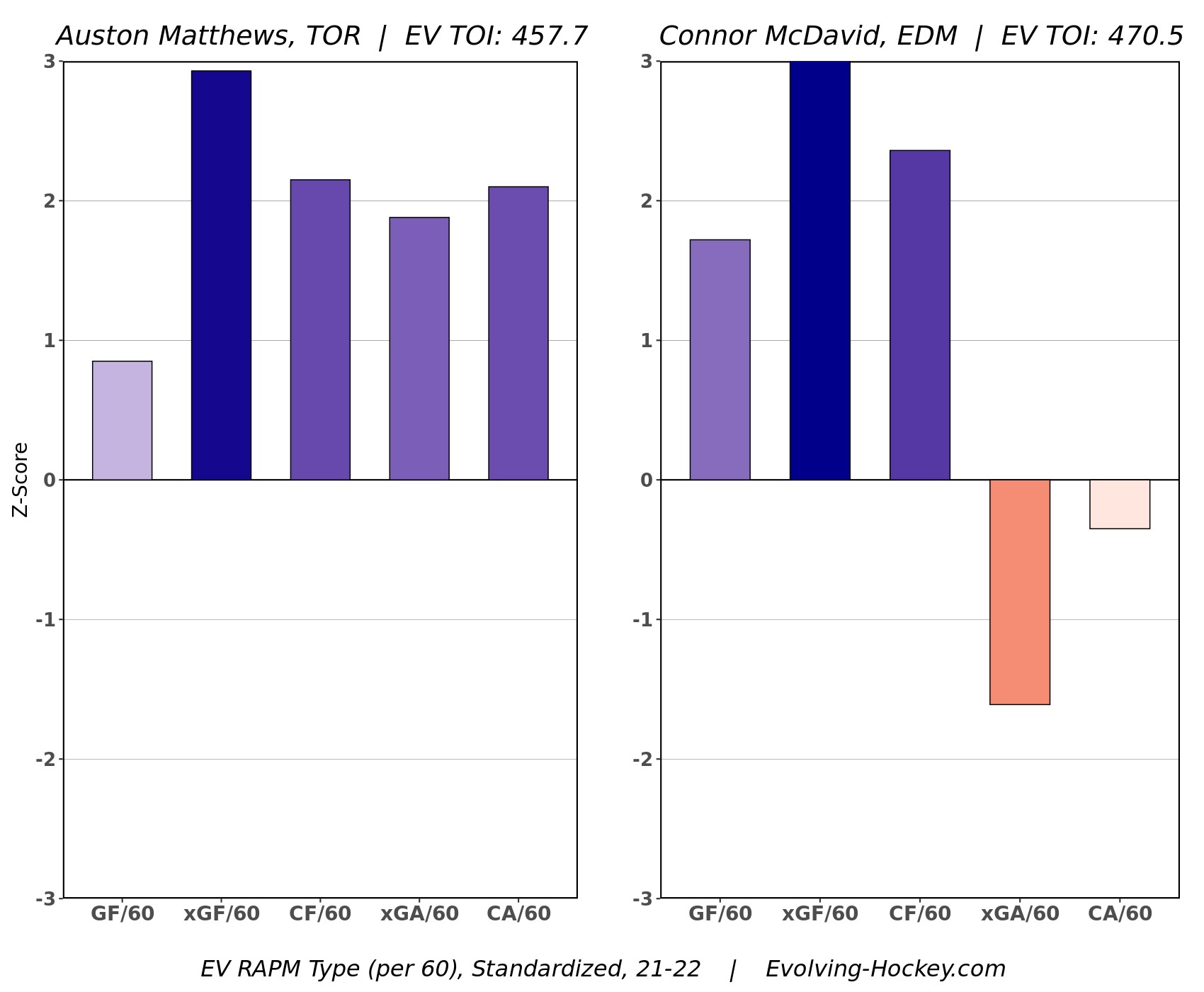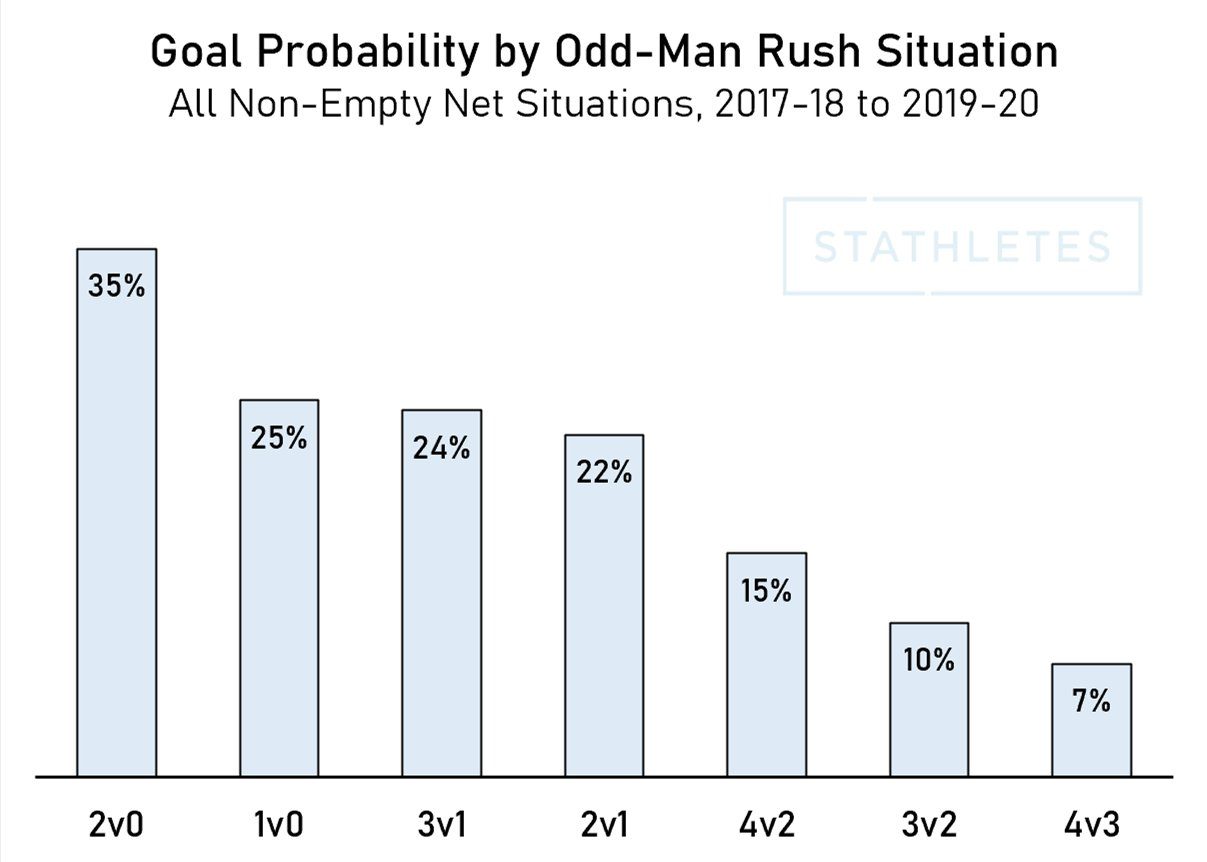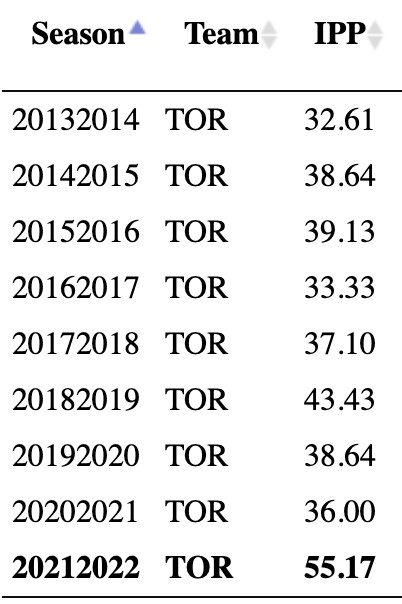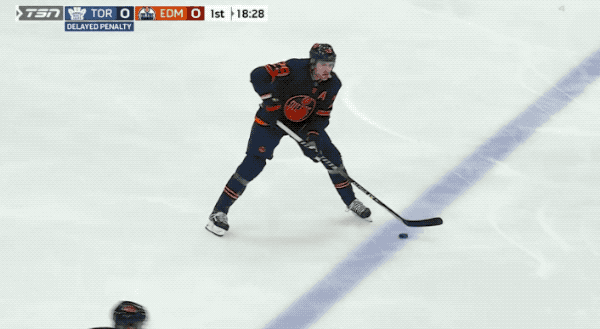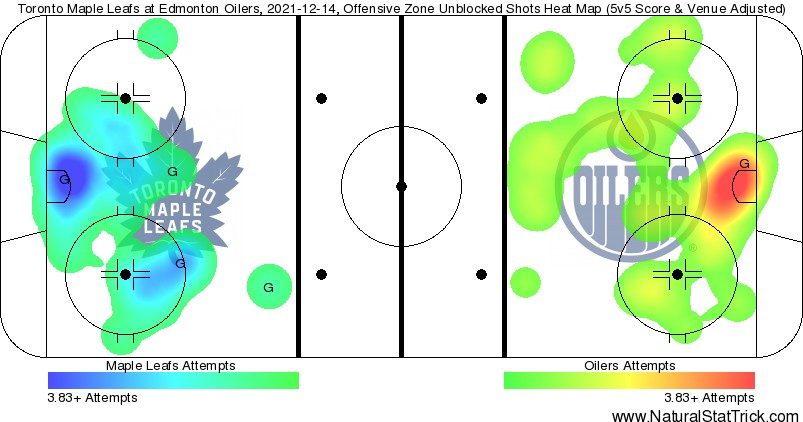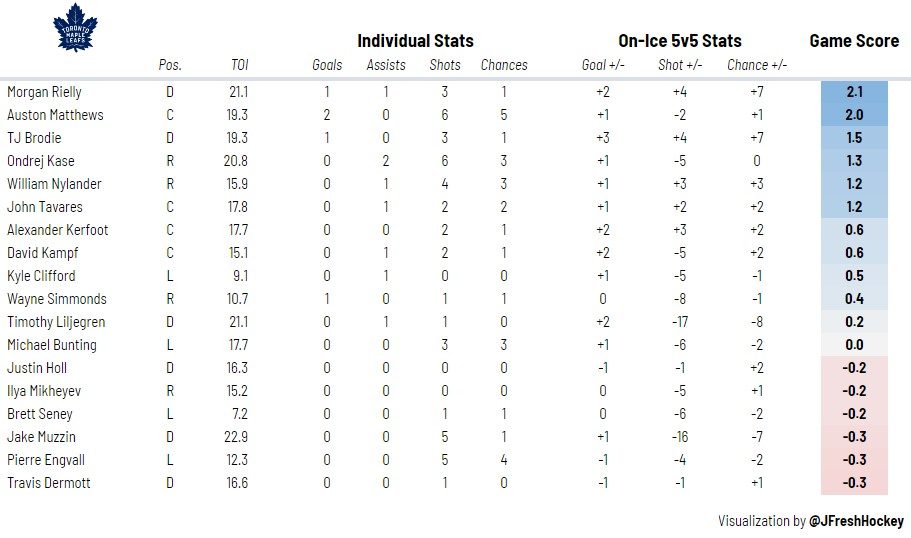Quality over quantity
In the sport of hockey, it’s typically a better outcome to generate more shots than your opponent, since we know it’s historically a good predictor of future goals. The caveat you’ll hear from coaches is that they care more about the scoring chances, hoping to win the shot quality battle with respect to creating more high-percentage looks than the opposition.
Mission accomplished in that department for Toronto last night.
Despite Edmonton controlling possession and shot totals for the majority of Tuesday night’s game, Toronto was organized in the neutral zone and limited rush chances against, holding Connor McDavid to zero carry-ins at 5v5. On the flip side of the equation, the Leafs were able to capitalize on their opportunities offensively, cashing in on a few odd-man rush opportunities thanks to Morgan Rielly jumping up in the play.
Defensively, that was a textbook game going up against McDavid that we just witnessed. Overall, I’m sure Sheldon Keefe & co. would’ve liked to see the Leafs do a better job of dictating play at even strength — by that, I mean winning pucks back higher up the ice and maintaining puck possession for longer stretches — but it’s hard to complain when you’re scoring on quick-strike plays off the counterattack.
These Leafs-Oilers games are always fun to break down — at least when you’re on the right side of a 5-1 victory — so let’s dive into things a bit deeper by breaking down each player individually. It’s time for some Leafs Report Cards!
5 Stars
Auston Matthews (C, #34) — His line went up against McDavid for about half their shifts and prevented the speedster from carrying the puck into the offensive zone at 5v5. That just doesn’t happen against #97, which speaks to how well Matthews was checking McDavid.
We all know what Matthews can do with the puck, but without it, he was staying above his man in the offensive zone, breaking up plays in the neutral zone and killing any potential rush opportunities early. Games like these help demonstrate the leap Matthews has made over the past couple of years in his 200-foot play, putting him in legitimate Selke consideration.
My favourite advanced metric for isolating 5v5 impact is “RAPM” (Regularized Adjusted Plus-Minus) from Evolving-Hockey.com, which uses fancy math to adjust for the quality of your linemates, opponents, zone starts, etc. The goal of the metric is to determine a player’s value at driving 5v5 play independent of their environment.
Blue is good.
You’ve probably seen these floated around on Hockey Twitter — or at least the nerdy side that I tend to obsess over. Matthews and McDavid are clearly dominant in the offensive categories (xGF/60 and CF/60), more than two standard deviations above the mean. The big differentiator is that Matthews is also doing an elite job of limiting chances and shots against at 5v5, currently sitting at two standard deviations above the mean.
McDavid is obviously the better driver of offense, currently on pace to score 140 points according to Dom Luszczyszyn’s latest projections. When you consider a player’s 200-foot impact at even strength, though, there’s a solid argument that Matthews has been just as dominant this year, doing so in a more balanced fashion.
He can also do this.
Classic.@AM34 | #LeafsForever pic.twitter.com/m9O0O0qstN
— Toronto Maple Leafs (@MapleLeafs) December 15, 2021
How many players in NHL history have scored over 50 goals while playing this level of defense? Matthews should have a legitimate chance to win the Rocket and Selke in the same season. We’re running out of words for how special of a player he is.
William Nylander (RW, #88) — It was cool getting to see Nylander mic’d up for this game. He’s consistently been Toronto’s most dangerous player off the rush, using his speed to fly up the ice into open space. That’s why I found it so interesting hearing him talk about zone entries with Ondrej Kase, trying to maximize the spacing after gaining the zone.
William Nylander talking hockey pic.twitter.com/dMLOGyYGkI
— Omar (@TicTacTOmar) December 15, 2021
These are the little nuances in hockey we often don’t hear discussed on the broadcast. Nylander has always been a zone entry wizard in transition — and clearly, there’s a method to the madness when you hear him get into detail about what he wants to do with those zone entries.
He generated a few good looks off the rush, getting behind Edmonton’s defenders multiple times, although his best moment came on a longer buildup play, transporting the puck from DZ to OZ.
Mo style the better 😎🎯#LeafsForever pic.twitter.com/tctlvfCs3C
— Toronto Maple Leafs (@MapleLeafs) December 15, 2021
As many have pointed out, that’s McDavid he beats down the ice, before delivering a behind-the-net pass to Rielly for the goal. He’s scoring over a point per game now, by the way.
Morgan Rielly (LD, #44) — He’s been on a tear lately, racking up 11 points in his last six games. Most of those are earned by beating his man up the ice in transition, giving Toronto lots of 3-on-2s and 4-on-3s off the rush. Any time you get numbers going up the ice, you’re tilting the odds in your team’s favour.
People like to make fun of me for using graphs, but how else can I quickly show you valuable information like this from Stathletes? Rielly gives up his fair share of odd-man rushes, too, but the net differential is still positive when he’s on the ice, which means more high-percentage chances for the Leafs.
His recent offensive explosion puts Rielly on pace for 71 points this season, which is crazy considering he’s doing it without going on a shooting percentage bender as he did in 2017-18.
That said, we should probably expect things to teeter off a bit based on his Individual Points Percentage. This is a metric that looks at what percentage of goals a player picked up a point on at 5v5. Historically, Rielly has lived in the high 30s.
This season, he’s at 55%.
Data from Natural Stat Trick
Anytime you have an outlier like this, you can expect things to regress closer to a player’s career average over time. 60 points might be more realistic, which is still excellent.
Jack Campbell (G, #36) — Oddly enough, McDavid wasn’t getting many point-blank chances in this game; it was Warren Foegele. We saw Jack Campbell shut the door on him a few times from in tight.
With goaltenders, I don’t want to pretend I fully understand the process behind how an NHL goalie stops the puck with consistency, but I can tell you when they’re doing it. When you adjust for shot quality, Campbell currently ranks first in all of the key goaltending metrics.
It’s reached the point where we’re almost taking it for granted that Toronto is going to receive Vezina-quality goaltending on a night-to-night basis, which can be a dangerous trap to fall into (just look at how the Rangers are playing defensively). The team in front of him made strides to reduce his workload with respect to quality chances against in this game, although Campbell was still forced to bail out Jake Muzzin and Justin Holl pretty consistently.
4 Stars
Ondrej Kase (RW, #25) — Nothing impacts your results more than the quality of your linemates. That’s why I’ve been so pleased to see Kase get some looks on PP1 with Toronto’s best players, not to mention some time away from David Kampf at 5v5.
It turns out when you play skilled players with other skilled players, they’ll make skilled plays. Who knew?
Kase also provided big-time value on the penalty kill, using his speed to take away space from McDavid and Draisaitl, never letting them get comfortable with the puck on the half-wall. That’s been a major theme on Dean Chynoweth’s PK this year and helps explain why the Leafs have done such a good job at limiting 4v5 shots and chances against, particularly when defending in-zone.
TJ Brodie (RD, #78) — If Matthews gets the most credit for limiting McDavid’s effectiveness off the rush last night, I’d argue Brodie deserves the second-most. With Rielly spending so much time up the ice creating offense, it’s up to Brodie to defend more open ice against the other team’s best players.
He did a great job in that department, gapping up at the right times and preventing McDavid from gaining the zone in transition.
Defending the rush is a skill and it’s one that Brodie has in spades.
3 Stars
John Tavares (C, #91) — He can have a quiet game and still pick up an assist plus a few chances from the slot just by dominating “his areas” of the ice. Tavares is so good at getting himself to dangerous areas in the offensive zone and navigating those tight spaces as a puck-handler.
When you throw in the ability to fight through contact and win 50-50 pucks, you essentially have a power forward with point-per-game upside offensively. I love the way Tavares is able to create a “skilled garbage goal” by going to the net, digging out a loose puck, and then making a high-level read in real-time to find an open player for a tap-in.
It was Matthews on the power play last night, but we’ll see that type of goal plenty of times in the future at 5v5.
Travis Dermott (LD, #23) — It turns out running Dermott-Holl out against McDavid is not a great idea. Dermott did drastically outplay his partner, though, actually defending Edmonton’s star players quite well in one-on-one situations. In fact, he even drew a penalty on Leon Draisaitl after gapping up on him and forcing a dump-in.
Travis Dermott has smothered several Oilers breakout attempts in the neutral zone tonight.
— Nick Richard (@_NickRichard) December 15, 2021
Those are the little plays I’ve always loved from Dermott’s game. Now if only he could make a dynamic play offensively; too often we see him make suicide passes in the neutral zone or dump the puck in after crossing center when he has passing options available to him.
The Makeshift Fourth Line — I wasn’t quite sure what to expect with a Clifford-Seney-Simmonds fourth line, but ended up being pleasantly surprised. Wayne Simmonds picked up a goal by driving hard to the net and converting on a rebound, finally getting a bit of Sh% luck that he’s been owed.
Then there’s Kyle Clifford, who everyone praises for his toughness but can actually play the sport of hockey.
Clifford’s a solid 13th fwd/different look guy for the leafs cause he can actually play, beyond the toughness/physical element. https://t.co/q9QSAka7gg
— Justin Bourne (@jtbourne) December 15, 2021
He’s not a player you should expect to score much if ever, but he’s consistently tilted the ice in fourth-line usage throughout his career because of his ability to complete the next pass and cycle his opponent’s to death in the offensive zone. This isn’t Colton Orr; this is an NHL hockey player.
Then there’s Brett Seney, who may or may not be. He made a nice play from the wall in the clip above but was otherwise pretty quiet in his 7:10 of ice time, which isn’t much of a showcase to be fair. His best shift actually came alongside Mikheyev-Kampf, who went digging for pucks in the corner while Seney was able to sneak into some open ice in the slot.
Timothy Liljegren — This is a weird one. His pairing with Jake Muzzin got shelled statistically, but I thought, individually, Liljegren played pretty well.
Now, he probably needs to stop going for so many of those home-run stretch passes, which either led to icings or the dreaded stretch pass tip-in we saw so often in the Mike Babcock era. Liljegren is a good puck mover, but he could definitely benefit from hitting his “checkdown” receiver instead of always going for the Hail Mary.
In contrast to Muzzin, Liljegren did a great job at keeping his man in front of him, closing the gap, and killing the rush.
2 Stars
The Engvall-Kampf-Mikheyev Experiment — I was really excited to see what these three could do together on an all-defense line. They’re so long and rangy that I figured they’d be super annoying to play against with the pressure they could apply on the forecheck and backcheck.
The thing with this strategy is it relies almost entirely on the top six producing. The top six should obviously be able to produce, but if they don’t… well, you saw what happened against Montreal in last year’s playoffs.
— Josh Simpson (@joshsimpson77) December 14, 2021
The reality is that there were not many completed plays on the ice from this line, which resulted in them not having the puck very often. It’s worth noting Ilya Mikheyev did have some moments on the forecheck, particularly on that shift with Seney. It’s hard to judge his game given the circumstances (playing his first regular-season game after months on the shelf), but Toronto’s newfangled third line may need a puck-transporter who can make a pass off the rush.
The Top 6 LWs — Michael Bunting did have a few chances offensively, but he was largely carried by Matthews and Kase at 5v5 in this one. It’s probably premature, but I couldn’t help but wonder if the NHL referees are starting to treat him like The Boy Who Cried Wolf, not giving him calls even when they’re deserved (i.e. the high stick he received last night).
I don’t want to turn this into a referendum on refereeing, even though it’s worth noting Brad Meier got to officiate last night’s game while Spezza served a suspension for a hit that went uncalled in the Jets game that was so poorly managed, but alas…
Let’s transition to Alex Kerfoot, who struggled to make plays in transition against the Oilers. His biggest asset is his speed through the neutral zone, so he needs to make more plays in that area of the rink.
It’s worth monitoring that this line has been outshot and out-chanced at 5v5 this season over a pretty decent sample now, even though they were a slight positive last night.
1 Star
Jake Muzzin — Another rough night. His pairing got absolutely shelled at even strength, particularly against McDavid.
The bad turnovers from Muzzin on the breakout are one thing, but what’s even more concerning is how he’s struggling with defending speed, getting beat to the outside with consistency.
Justin Holl (RD, #3) — Oh boy,
I genuinely feel bad at this point. What else is there left to say? Holl just doesn’t look like the guy we saw move the puck consistently over the last two seasons. He’s playing with zero confidence right now, skating the puck into bad ice and losing it in the corner for no reason.
He actually defended the rush better last night than we’ve seen in recent games, but his inability to complete a breakout pass is preventing the Leafs from getting out of their zone. They spend way too many shifts hemmed in when Holl is on the ice this season, regardless of who he plays with.
Is now a good time to bring up the Jared McCann decision? No? Just checking.
Heat Map
Here’s a quick look at where each team’s shots were coming from at even strength, courtesy of Natural Stat Trick.
As we mentioned, the Leafs did not control shot quantity in the game, only generating 48 percent of the total attempts at the net at 5v5. The good news is that they had 56 percent of the scoring chances.
Game Score
Game score is a metric developed by The Athletic’s Dom Luszczyszyn to measure single-game performance. You can read more about it here.
Tweets of the Night
the numbers don't lie pic.twitter.com/twzLG7oMJw
— Acting the Fulemin (@ATFulemin) December 15, 2021
Can’t argue with those numbers, which certainly aren’t made up.
It’s the little mouth twitch for me. https://t.co/ZYLwlSG498
— Down Goes Brown (@DownGoesBrown) December 15, 2021
It’s really not fair that the best player in the world is forced to play on a team whose bottom six is rocking a -19 goal differential. Someone please help this man.
Auston Matthews, Steph Curry.
Tonight we honour the best shooters in the game
— JD Bunkis (@JDBunkis) December 15, 2021
There’s something about watching greatness that makes sports special. The ease with which these players can get their release off from distance and consistently score is just absurd. It contorts the spacing of opposing defenses like crazy and they’re still not able to stop them from doing what they do best.
God, I love sports.
























